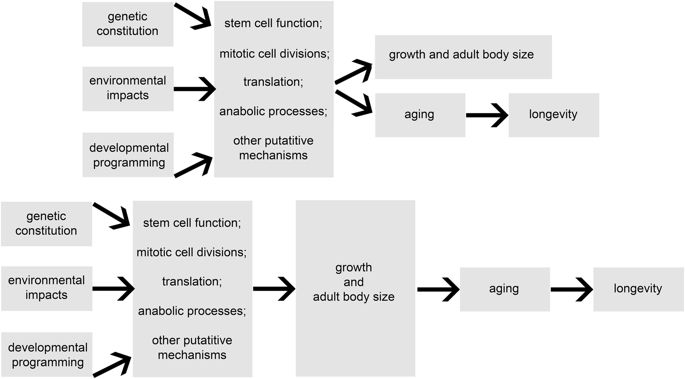npj Aging ( IF 4.1 ) Pub Date : 2017-09-29 , DOI: 10.1038/s41514-017-0014-y Andrzej Bartke

|
Although larger species of animals typically live longer than smaller species, the relationship of body size to longevity within a species is generally opposite. The longevity advantage of smaller individuals can be considerable and is best documented in laboratory mice and in domestic dogs. Importantly, it appears to apply broadly, including humans. It is not known whether theses associations represent causal links between various developmental and physiological mechanisms affecting growth and/or aging. However, variations in growth hormone (GH) signaling are likely involved because GH is a key stimulator of somatic growth, and apparently also exerts various “pro-aging” effects. Mechanisms linking GH, somatic growth, adult body size, aging, and lifespan likely involve target of rapamycin (TOR), particularly one of its signaling complexes, mTORC1, as well as various adjustments in mitochondrial function, energy metabolism, thermogenesis, inflammation, and insulin signaling. Somatic growth, aging, and longevity are also influenced by a variety of hormonal and nutritional signals, and much work will be needed to answer the question of why smaller individuals may be likely to live longer.
中文翻译:

体细胞生长,衰老和寿命
尽管较大的动物通常比较小的动物寿命更长,但动物体型与寿命的关系通常是相反的。较小个体的长寿优势可能相当可观,并且最好在实验室小鼠和家养犬中得到证明。重要的是,它似乎广泛地适用于人类。这些关联是否代表影响生长和/或衰老的各种发育和生理机制之间的因果关系,这一点尚不清楚。但是,可能涉及生长激素(GH)信号的变化,因为GH是体细胞生长的关键刺激剂,并且显然还发挥了各种“衰老”效应。与GH,体细胞生长,成年体重,衰老和寿命相关的机制可能涉及雷帕霉素(TOR)的靶标,尤其是其信号复合物之一mTORC1,以及线粒体功能,能量代谢,生热,炎症和胰岛素信号传导的各种调节。体激素的生长,衰老和寿命也受到各种激素和营养信号的影响,因此需要做大量的工作来回答为什么较小的人可能寿命更长的问题。











































 京公网安备 11010802027423号
京公网安备 11010802027423号